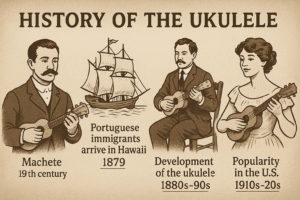
The ukulele may be small in size, but its history is rich, diverse, and full of cultural significance. From the sun-soaked islands of Hawaii to global music stages, the ukulele has earned a beloved spot in the hearts of musicians and listeners alike. Whether you’re a player or simply curious about this four-stringed wonder, understanding ukulele history helps appreciate its charm even more.
Let’s dive into the captivating journey of the ukulele—from its roots in Portugal to becoming a Hawaiian cultural symbol and international sensation.
The Portuguese Roots of the Ukulele
Although the ukulele is deeply associated with Hawaiian music and culture, its story actually begins in 19th-century Portugal. Specifically, the instrument evolved from a small stringed instrument called the machete, which originated in the Madeira region.
In 1879, Portuguese immigrants—mainly from Madeira and Cape Verde—arrived in Hawaii to work in sugarcane plantations. Among them were three woodworkers: Manuel Nunes, José do Espírito Santo, and Augusto Dias. These men brought their machetes with them and soon began crafting similar instruments using local Hawaiian wood, slightly altering the design.
The Hawaiians were captivated by the sound and appearance of the instrument. It was nimble, bright-sounding, and perfect for accompanying traditional Hawaiian songs and chants.
The Name “Ukulele” and Its Meaning
The word “ukulele” is often translated as “jumping flea” in Hawaiian. While the origin of the name is still debated, the most popular explanation is that it described the rapid finger movement of early players on the fretboard—resembling tiny jumping fleas.
Some historical accounts also tie the name to Edward Purvis, a British army officer who was a court musician for King Kalākaua. Known for his lively playing style, Purvis was nicknamed “ukulele,” which eventually stuck to the instrument itself.
Royal Patronage and Rising Popularity in Hawaii
The ukulele’s true rise in popularity began in the late 1800s, largely thanks to King David Kalākaua, also known as the “Merrie Monarch.” A passionate supporter of Hawaiian culture and the arts, Kalākaua embraced the ukulele as a key element in court performances and traditional hula.
Under royal patronage, the ukulele became more than just a novelty—it evolved into a respected and beloved part of Hawaiian identity. By the early 20th century, it was widely played at social events, luaus, and public gatherings across the islands.
Spreading to the Mainland: Ukulele in the U.S.
The ukulele made its American mainland debut during the Panama-Pacific International Exposition in San Francisco in 1915. Hawaiian musicians performed at the event, mesmerizing audiences with their exotic melodies and upbeat rhythms.
Soon, the ukulele became a national sensation. Its small size, affordability, and easy-to-learn structure made it a perfect entry point for aspiring musicians.
By the 1920s, it was deeply embedded in American popular culture. Music publishers began including ukulele chord diagrams in sheet music. Radio shows, vaudeville acts, and even early cartoons featured the cheerful strums of the ukulele.
A Timeless Instrument: Evolution Through the Decades
1930s–1950s: Hollywood and Jazz
In the post-World War II era, Hollywood stars like Arthur Godfrey promoted the ukulele on television. It also found a place in early jazz and swing music. Manufacturers like Martin and Kamaka gained prominence for producing high-quality instruments.
1960s–1980s: A Decline in Popularity
With the rise of electric guitars and rock music, the ukulele’s popularity took a dip. It was often relegated to novelty status or children’s music.
1990s–Present: The Revival
Thanks to artists like Israel Kamakawiwoʻole (with his iconic rendition of “Somewhere Over the Rainbow”), Jake Shimabukuro, and later, YouTube musicians, the ukulele experienced a powerful revival.
Today, it is a mainstay in schools, homes, and stages around the world.
💡 For more quirky and detailed stories behind the ukulele’s journey, check out this in-depth article: The Curious Saga of the Ukulele
Cultural Impact and Global Reach
The ukulele has become a symbol of joy, simplicity, and creative expression. Its portability and accessibility have turned it into a global instrument used in a wide variety of genres, including:
-
Pop
-
Folk
-
Reggae
-
Jazz
-
Classical
-
Indie Rock
Moreover, its friendly learning curve makes it a favorite in music education for both children and adults.
In recent years, ukulele festivals have emerged worldwide—in places like the U.S., U.K., Japan, Australia, and even Finland. It’s not just a Hawaiian thing anymore—it’s a global phenomenon.
Fun Facts About Ukulele History
-
Elvis Presley, the King of Rock ‘n’ Roll, played the ukulele in several of his Hawaiian-themed films.
-
The Beatles—especially George Harrison—loved playing the ukulele and often used it during jam sessions.
-
The world’s largest playable ukulele was created in Italy and measures over 13 feet long.
-
There are four standard types of ukuleles: soprano, concert, tenor, and baritone—each with its own unique sound and tuning.
Why Learn the Ukulele Today?
Aside from its rich history, the ukulele continues to be a go-to instrument for beginners and pros alike. Here’s why:
-
It’s affordable: You can start with a quality ukulele without breaking the bank.
-
It’s beginner-friendly: Learn basic chords in a day.
-
It’s portable: Bring it anywhere—from beach trips to open mic nights.
-
It sparks creativity: Its unique tone encourages songwriting and experimenting.
-
It’s therapeutic: Many people use it for stress relief and mindfulness.
Final Thoughts
The story of the ukulele is a global tale of music, migration, and cultural fusion. From Portuguese ship decks to Hawaiian royalty, and from dusty 1920s speakeasies to viral internet covers, ukulele history is proof that even the smallest instrument can leave a big mark.
As you pick up a ukulele or listen to its charming strums, you’re participating in a tradition that spans over a century and continues to inspire across continents.
So whether you’re a seasoned player or simply a curious listener, remember: every time you hear a ukulele, you’re hearing history.

